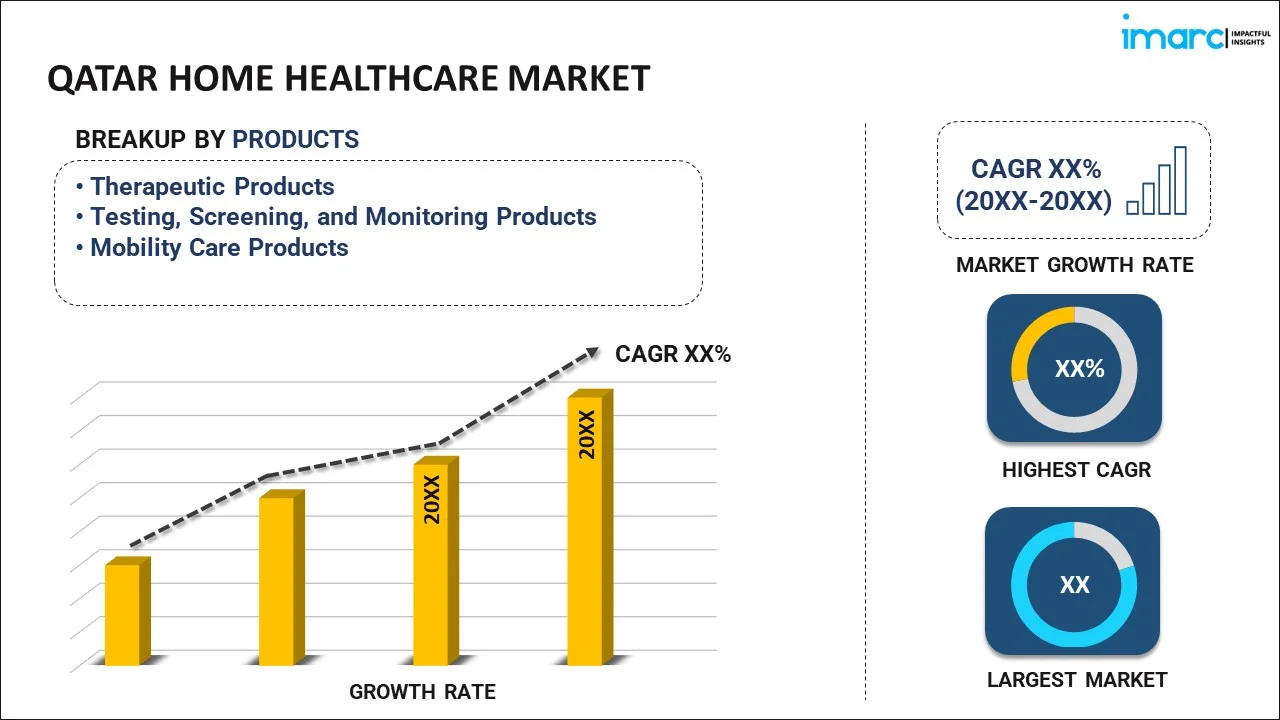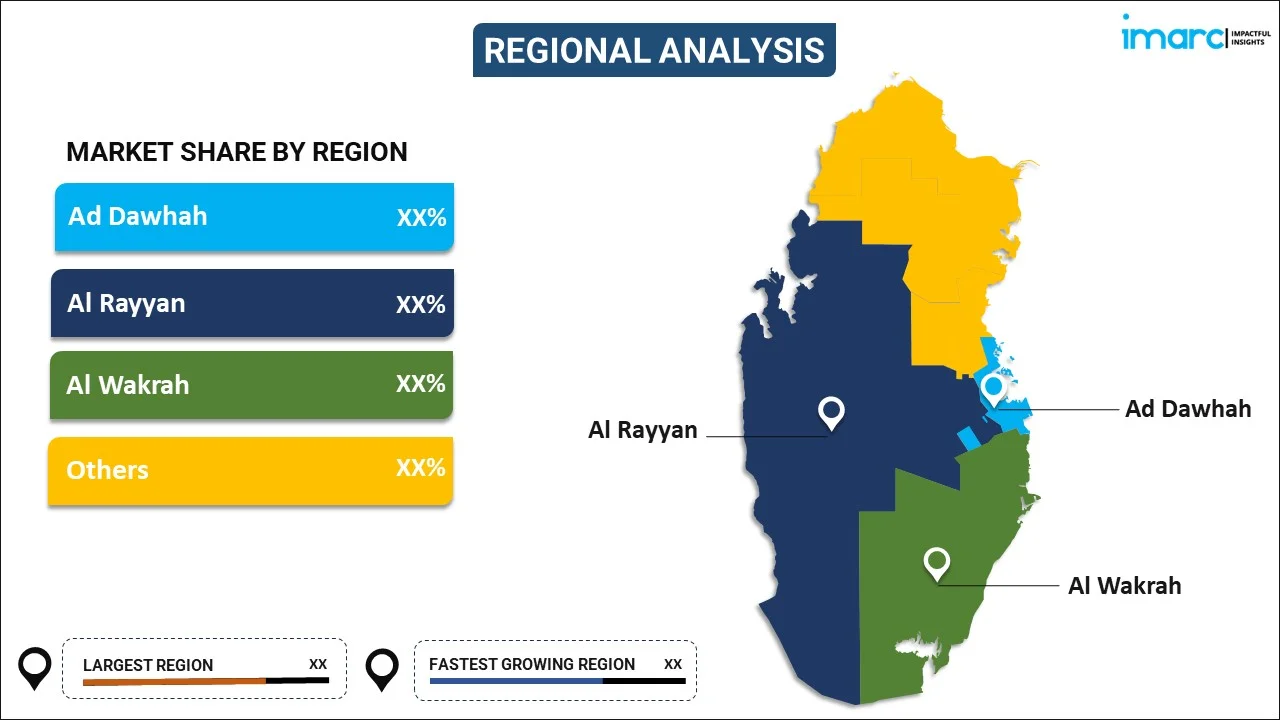
Qatar Home Healthcare Market Report by Product (Therapeutic Products, Testing, Screening, and Monitoring Products, Mobility Care Products), Service (Skilled Nursing, Rehabilitation Therapy, Hospice and Palliative Care, Unskilled Care, Respiratory Therapy, Infusion Therapy, Pregnancy Care), Indication (Cancer, Respiratory Diseases, Movement Disorders, Cardiovascular Diseases and Hypertension, Pregnancy, Wound Care, Diabetes, Hearing Disorders, and Others), and Region 2024-2032
Qatar Home Healthcare Market Overview:
The Qatar home healthcare market size reached US$ 1.6 Billion in 2023. Looking forward, IMARC Group expects the market to reach US$ 3.1 Billion by 2032, exhibiting a growth rate (CAGR) of 7.82% during 2024-2032. The market is experiencing significant growth driven by the rising geriatric population, increasing chronic diseases, favorable government initiatives promoting healthcare accessibility, growing prevalence of lifestyle-related health issues, and ongoing technological advancements in home healthcare solutions.
|
Report Attribute
|
Key Statistics
|
|---|---|
|
Base Year
|
2023
|
|
Forecast Years
|
2024-2032
|
|
Historical Years
|
2018-2023
|
|
Market Size in 2023
|
US$ 1.6 Billion |
|
Market Forecast in 2032
|
US$ 3.1 Billion |
| Market Growth Rate 2024-2032 | 7.82% |
Qatar Home Healthcare Market Trends:
Rising Aging Population and Chronic Diseases
Qatar's demographic landscape, marked by an aging population and a rising incidence of chronic diseases like diabetes and cardiovascular conditions, is significantly influencing the demand for home healthcare services. According to the Qatar Public Health Strategy, chronic diseases such as diabetes and cardiovascular conditions are increasingly common, necessitating ongoing medical care and monitoring at home. This trend emphasizes the necessity for personalized healthcare solutions that cater specifically to the needs of elderly and chronically ill individuals, ensuring both comfort and continuity of care. By providing medical services at home, these solutions not only improve the quality of life for patients but also alleviate pressure on traditional healthcare facilities, enhancing overall healthcare efficiency and accessibility in response to Qatar's evolving healthcare needs.
Favorable Government Initiatives
Qatar's government is actively working to enhance healthcare accessibility through initiatives. For instance, the National Health Strategy 2018-2022 emphasizes expanding healthcare services In Qatar, including the promotion of preventive and community-based care and specifically supports the development of home healthcare services. These services should become more accessible and affordable for Qatari citizens due to government funding and support programs. In prevention and community care, the health sector of Qatar has set its target to enhance the general health of the people and effectively control chronic diseases. Such strategies conform with the world trends in the development of healthcare and meet the needs of the Qatari population, considering the trends in the development of healthcare services, including home healthcare services.
Increasing Prevalence of Lifestyle-Related Health Issues
Qatar is witnessing a rise in lifestyle-related health issues such as obesity and hypertension. For instance, the Qatar National Health Strategy reported the significant impact of lifestyle choices on public health. These are among the reasons the strategy proposed targets timely healthcare intercessions such as home-based monitoring and management programs. Through the provision of Home Care Services, the Qatar healthcare system seeks to reduce ailments that are associated with home and lifestyle diseases across the population. These programs do help people to take care of themselves in familiar environments and help to alleviate demand for conventional healthcare organizations. Thus, in these programs, Qatar aims to raise a healthier nation where people adopt preventive measures along with receiving an individualized approach to available health care.
Qatar Home Healthcare Market News:
- In July 2023, Qatar's Health Ministry announced a new policy aimed at regulating home nursing services to enhance quality and oversight, ensuring standards of care and patient safety are maintained across all providers in the sector.
- In April 2024, Qatar Care won the Healthcare Asia Awards 2024 for its excellence in home care and employee engagement Initiatives. This recognition underscores Qatar Care's commitment to delivering high-quality home healthcare services while fostering a supportive and engaged work environment for its employees.
Qatar Home Healthcare Market Segmentation:
IMARC Group provides an analysis of the key trends in each segment of the market, along with forecasts at the country level for 2024-2032. Our report has categorized the market based on product, service, and indication.
Product Insights:

- Therapeutic Products
- Testing, Screening, and Monitoring Products
- Mobility Care Products
The report has provided a detailed breakup and analysis of the market based on the product. This includes therapeutic products, testing, screening, and monitoring products, and mobility care products.
Service Insights:
- Skilled Nursing
- Rehabilitation Therapy
- Hospice and Palliative Care
- Unskilled Care
- Respiratory Therapy
- Infusion Therapy
- Pregnancy Care
A detailed breakup and analysis of the market based on the service have also been provided in the report. This includes skilled nursing, rehabilitation therapy, hospice and palliative care, unskilled care, respiratory therapy, infusion therapy, and pregnancy care.
Indication Insights:
- Cancer
- Respiratory Diseases
- Movement Disorders
- Cardiovascular Diseases and Hypertension
- Pregnancy
- Wound Care
- Diabetes
- Hearing Disorders
- Others
The report has provided a detailed breakup and analysis of the market based on the indication. This includes cancer, respiratory diseases, movement disorders, cardiovascular diseases and hypertension, pregnancy, wound care, diabetes, hearing disorders, and others.
Regional Insights:

- Ad Dawhah
- Al Rayyan
- Al Wakrah
- Others
The report has also provided a comprehensive analysis of all the major regional markets, which include Ad Dawhah, Al Rayyan, Al Wakrah, and Others.
Competitive Landscape:
The market research report has also provided a comprehensive analysis of the competitive landscape in the market. Competitive analysis such as market structure, key player positioning, top winning strategies, competitive dashboard, and company evaluation quadrant has been covered in the report. Also, detailed profiles of all major companies have been provided.
Qatar Home Healthcare Market Report Coverage:
| Report Features | Details |
|---|---|
| Base Year of the Analysis | 2023 |
| Historical Period | 2018-2023 |
| Forecast Period | 2024-2032 |
| Units | US$ Billion |
| Scope of the Report | Exploration of Historical Trends and Market Outlook, Industry Catalysts and Challenges, Segment-Wise Historical and Future Market Assessment:
|
| Products Covered | Therapeutic Products, Testing, Screening, and Monitoring Products, Mobility Care Products |
| Services Covered | Skilled Nursing, Rehabilitation Therapy, Hospice and Palliative Care, Unskilled Care, Respiratory Therapy, Infusion Therapy, Pregnancy Care |
| Indications Covered | Cancer, Respiratory Diseases, Movement Disorders, Cardiovascular Diseases and Hypertension, Pregnancy, Wound Care, Diabetes, Hearing Disorders, Others |
| Regions Covered | Ad Dawhah, Al Rayyan, Al Wakrah, Others |
| Customization Scope | 10% Free Customization |
| Post-Sale Analyst Support | 10-12 Weeks |
| Delivery Format | PDF and Excel through Email (We can also provide the editable version of the report in PPT/Word format on special request |
Key Questions Answered in This Report:
- How has the Qatar home healthcare market performed so far and how will it perform in the coming years?
- What has been the impact of COVID-19 on the Qatar home healthcare market?
- What is the breakup of the Qatar home healthcare market on the basis of product?
- What is the breakup of the Qatar home healthcare market on the basis of service?
- What is the breakup of the Qatar home healthcare market on the basis of indication?
- What are the various stages in the value chain of the Qatar home healthcare market?
- What are the key driving factors and challenges in the Qatar home healthcare?
- What is the structure of the Qatar home healthcare market and who are the key players?
- What is the degree of competition in the Qatar home healthcare market?
Key Benefits for Stakeholders:
- IMARC’s industry report offers a comprehensive quantitative analysis of various market segments, historical and current market trends, market forecasts, and dynamics of the Qatar home healthcare market from 2018-2032.
- The research report provides the latest information on the market drivers, challenges, and opportunities in the Qatar home healthcare market.
- Porter's five forces analysis assist stakeholders in assessing the impact of new entrants, competitive rivalry, supplier power, buyer power, and the threat of substitution. It helps stakeholders to analyze the level of competition within the Qatar home healthcare industry and its attractiveness.
- Competitive landscape allows stakeholders to understand their competitive environment and provides an insight into the current positions of key players in the market.
Need more help?
- Speak to our experienced analysts for insights on the current market scenarios.
- Include additional segments and countries to customize the report as per your requirement.
- Gain an unparalleled competitive advantage in your domain by understanding how to utilize the report and positively impacting your operations and revenue.
- For further assistance, please connect with our analysts.
 Inquire Before Buying
Inquire Before Buying
 Speak to an Analyst
Speak to an Analyst
 Request Brochure
Request Brochure
 Request Customization
Request Customization




.webp)




.webp)












